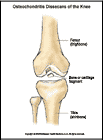
Osteochondritis Dissecans (Bone Chips) of the Knee
What is osteochondritis dissecans of the knee?
Osteochondritis dissecans of the knee is a disorder in which fragments of bone or cartilage come loose and float around in the knee joint. Other terms for this condition are chondral fracture and osteochondral fracture. The fragments may also be referred to as a joint mouse or loose bodies.
How does it occur?
There has usually been a previous injury to the knee that caused a fragment of bone or cartilage to be chipped off the back of the kneecap or the top part of the knee joint.
What are the symptoms?
Your knee may lock up from time to time. You may see bulges along the joint surface. You may be able to feel these chips or loose bodies along the surface of your knee joint at various times. Your knee can become swollen and painful. You may not be able to fully bend or straighten your knee.
How is it diagnosed?
Your health care provider will examine your knee and may find that it clicks or locks. Fragments may be felt along the joint line. An x-ray or a magnetic resonance imaging (MRI) may show bony fragments.
How is it treated?
Loose bodies causing symptoms may need to be surgically removed. Large defects along the joint surface may need to be surgically corrected.
When can I return to my sport or activity?
The goal of rehabilitation is to return you to your sport or activity as soon as is safely possible. If you return too soon you may worsen your injury, which could lead to permanent damage. Everyone recovers from injury at a different rate. Return to your sport or activity will be determined by how soon your knee recovers, not by how many days or weeks it has been since your injury occurred. In general, the longer you have symptoms before you start treatment, the longer it will take to get better.
You may safely return to your sport or activity when, starting from the top of the list and progressing to the end, each of the following is true:
- Your injured knee can be fully straightened and bent without pain.
- Your knee and leg have regained normal strength compared to the uninjured knee and leg.
- Your knee is not swollen.
- You are able to jog straight ahead without limping.
- You are able to sprint straight ahead without limping.
- You are able to do 45-degree cuts.
- You are able to do 90-degree cuts.
- You are able to do 20-yard figure-of-eight runs.
- You are able to do 10-yard figure-of-eight runs.
- You are able to jump on both legs without pain and jump on the injured leg without pain.
If you feel that your knee is giving way or if you develop pain or have swelling in your knee, you should see your health care provider. If your condition required surgery, ask your provider when you can return to your sport or activity.
How can I prevent osteochondritis dissecans of the knee?
Osteochondritis dissecans is usually caused by trauma to the knee and is not preventable.

